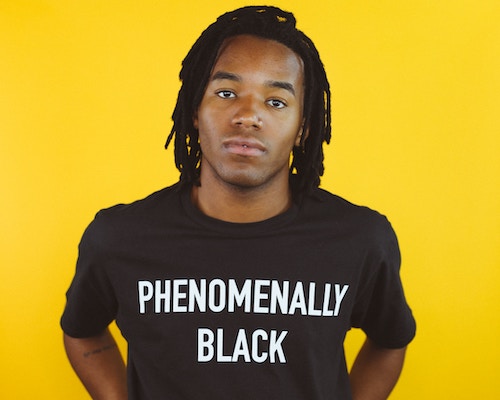
For those who are familiar with Maslow’s Hierarchy of Needs, you might recognize esteem as the fourth level of human needs. We need to feel a sense of respect, appreciation, and worth, both from others and within. When we are not given the opportunity to develop esteem, the ripples are felt far beyond our family, social circles, and community.
In the simplest terms, “Low self-esteem refers to long-term negativity about who you are and how you show up in the world.” This can, and often does, play out as a lack of motivation, increased vulnerability to peer pressure, insecurity, and an overall decrease in confidence.
For Black adolescent males, particularly in underserved communities, a lack of self-esteem can have catastrophic and far-reaching consequences. The challenges our Black youths face come as no surprise, but why are they uniquely affected by low self-esteem and what can we, as a community, do to uplift them?
Discrimination and Self-Image
For better or worse, our ability to receive vast amounts of information throughout the day makes things such as discrimination more visible beyond that of just our lived experience. Children and young adults are always watching, learning, and absorbing.
When they see these negative images of Black males regularly perpetuated in the media—angry, violent, impoverished, abusing substances—it can have a lasting effect on how they view themselves and their place in the world. This is as true in the news as it is in scripted television.
Further, research has found that young Black males are viewed as older and less innocent than their white peers.
“The study also involved 264 mostly white, female undergraduate students from large public U.S. universities. In one experiment, students rated the innocence of people ranging from infants to 25-year-olds who were black, white or an unidentified race. The students judged children up to 9 years old as equally innocent regardless of race, but considered black children significantly less innocent than other children in every age group beginning at age 10, the researchers found.
The students were also shown photographs alongside descriptions of various crimes and asked to assess the age and innocence of white, black or Latino boys ages 10 to 17. The students overestimated the age of blacks by an average of 4.5 years and found them more culpable than whites or Latinos, particularly when the boys were matched with serious crimes, the study found.”
How can we hope to reinforce a positive self-image and confidence when it seems that, at every step along the way, discrimination reinforces that being a Black male means you are all but destined for poverty, violence, and a life of crime?
Poverty and Self-Esteem
When considering the impact of poverty, it’s easy to get lost in surface-level consequences. We focus on the lack of resources, poor living conditions, and other necessities that are out of reach for those in the lower-income bracket. There are, however, much deeper implications.
Take, for instance, the 1983 satire Trading Places. In it, Dan Aykroyd and Eddie Murphy’s characters, Louis Winthorpe III and Billy Ray Valentine respectively, are unwittingly made part of a bet by two wealthy brokers. The wager? That if Valentine, a hustler from an impoverished background, is given all the advantages of Winthorpe’s privileged life, he would begin to act like the city’s elite, and vice-versa. The movie brilliantly plays out the theme that wealth and poverty, luxury and lack, can shape behaviors and perceptions, but also that these behaviors aren’t set in stone.
Poverty can have a profoundly negative effect on self-esteem, as it strips away the ability to make choices and control one’s life. Just as Trading Places showed how Winthorpe struggled and became disoriented when thrust into a life of hardship. It can lead to feelings of hopelessness, worthlessness, and helplessness.
Not only that, young people in these situations typically have less adult supervision as, often, parents are working multiple jobs in order to make ends meet. Financial strain, in addition to other poverty-related issues, can greatly impact the parent-child relationship as well, leading to decreased parental involvement.
In these formative years, it is crucial that youths feel respect, appreciation, and support. When this is not possible, they will seek it out in other places.
Searching for Belonging
When we discuss self-esteem, we must also bring belongingness into the conversation. The two are so closely tied that it is nearly impossible to talk about one without the other.
Belonging comes just before esteem in Maslow’s Hierarchy of Needs, and it is the sense of acceptance, companionship, and community that creates a solid foundation for us to grow.
Unfortunately, in many underserved communities, belonging can be hard to find. It can be difficult to find healthy ways to cope with poverty, hunger, discrimination, systemic racism and other issues many young Black boys and men face, leading to the search for acceptance and approval outside of the home.
Belonging is cited as a significant motivator for joining a gang. They believe gangs will provide not only physical protection but the connectedness, appreciation, and respect they feel they lack elsewhere.
It’s a tale we know all too well in our community–one that rarely has a happy ending.
How Can We Uplift Our Young Black Men?
It’s clear that there is no one direct solution to the challenge at hand. We must begin by recognizing that self-esteem is a fundamental human right. It should be treated as such, with the same level of importance we give to access to education or healthcare.
In a world where self-esteem can come so easily to some, it’s all too easy to overlook its significance, particularly in minority populations. But, Black youths deserve to feel good about themselves.
It is not good enough to simply tell our children that the stereotypes, microaggressions, and systemic racism are wrong; we need to help them to develop a sense of self-worth that is not dependent upon external validation or approval. We must provide them with the tools and resources they need to achieve success in all aspects of their lives.
These can include:
• Mentorship programs that provide one-on-one guidance and support
• Access to therapy or counseling
• Community-based events and activities that focus on positive reinforcement
• Safe spaces to discuss their feelings and build relationships.
Finally, we must strive to create an environment where our Black adolescent men can meet their fundamental needs and have access to resources for physical, mental, and emotional growth. This begins at home but shouldn’t end there. Non-family adult mentors can provide invaluable and objective guidance, support, and positive reinforcement.
It’s true what they say—it takes a village.
The most important thing we can do is to show up fully engaged and with an open heart. For some, this may require addressing our own unconscious bias, self-esteem issues, and other preconceived notions. Deconstructing these personal beliefs will equip us to become stronger role models and resources.
Ultimately, the responsibility lies with all of us—parents, educators, policy makers, neighbors—we must work together to create a world where young Black men are seen with the great capacity for love, kindness, and success that lies within them. When we do this, we will experience them rise to and beyond the occasion. And we believe, the entire world will benefit from it.
